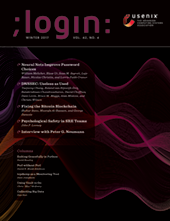USENIX supports diversity, equity, and inclusion and condemns hate and discrimination.
An End-to-End View of DNSSEC Ecosystem Management
;login: Enters a New Phase of Its Evolution
For over 20 years, ;login: has been a print magazine with a digital version; in the two decades previous, it was USENIX’s newsletter, UNIX News. Since its inception 45 years ago, it has served as a medium through which the USENIX community learns about useful tools, research, and events from one another. Beginning in 2021, ;login: will no longer be the formally published print magazine as we’ve known it most recently, but rather reimagined as a digital publication with increased opportunities for interactivity among authors and readers.
Since USENIX became an open access publisher of papers in 2008, ;login: has remained our only content behind a membership paywall. In keeping with our commitment to open access, all ;login: content will be open to everyone when we make this change. However, only USENIX members at the sustainer level or higher, as well as student members, will have exclusive access to the interactivity options. Rik Farrow, the current editor of the magazine, will continue to provide leadership for the overall content offered in ;login:, which will be released via our website on a regular basis throughout the year.
As we plan to launch this new format, we are forming an editorial committee of volunteers from throughout the USENIX community to curate content, meaning that this will be a formally peer-reviewed publication. This new model will increase opportunities for the community to contribute to ;login: and engage with its content. In addition to written articles, we are open to other ideas of what you might want to experience.

The Domain Name System (DNS) provides name resolution for the Internet, and DNS’s Security Extensions (DNSSEC) allow clients and resolvers to verify that DNS responses have not been forged. DNSSEC can operate securely only if each of its principals performs its management tasks correctly: authoritative name servers must generate and publish their keys and signatures, domains that support DNSSEC must be signed with their parent’s keys, and resolvers must actually validate the chain of signatures. We perform the first large-scale measurement study into how well DNSSEC’s PKI is managed, studying the behavior of domain operators, registrars, and resolvers. Our investigation reveals pervasive mismanagement of the DNSSEC infrastructure: only 1% of the .com, .org, and .net domains attempt to deploy DNSSEC; many popular registrars that support DNSSEC fail to publish all relevant records required for validation; and only 12% of resolvers that request DNSSEC records actually attempt to validate them.

